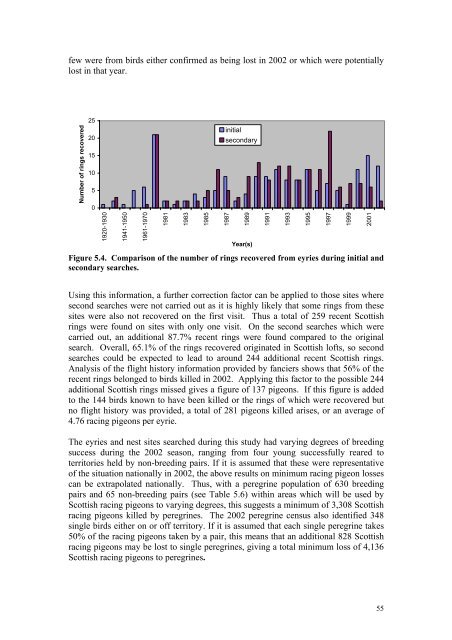RACING PIGEONS â IMPACT OF RAPTOR PREDATION
RACING PIGEONS â IMPACT OF RAPTOR PREDATION
RACING PIGEONS â IMPACT OF RAPTOR PREDATION
You also want an ePaper? Increase the reach of your titles
YUMPU automatically turns print PDFs into web optimized ePapers that Google loves.
few were from birds either confirmed as being lost in 2002 or which were potentially<br />
lost in that year.<br />
25<br />
Number of rings recovered<br />
20<br />
15<br />
10<br />
5<br />
0<br />
initial<br />
secondary<br />
1920-1930<br />
1941-1950<br />
1961-1970<br />
1981<br />
1983<br />
1985<br />
1987<br />
1989<br />
Year(s)<br />
1991<br />
1993<br />
1995<br />
1997<br />
1999<br />
2001<br />
Figure 5.4. Comparison of the number of rings recovered from eyries during initial and<br />
secondary searches.<br />
Using this information, a further correction factor can be applied to those sites where<br />
second searches were not carried out as it is highly likely that some rings from these<br />
sites were also not recovered on the first visit. Thus a total of 259 recent Scottish<br />
rings were found on sites with only one visit. On the second searches which were<br />
carried out, an additional 87.7% recent rings were found compared to the original<br />
search. Overall, 65.1% of the rings recovered originated in Scottish lofts, so second<br />
searches could be expected to lead to around 244 additional recent Scottish rings.<br />
Analysis of the flight history information provided by fanciers shows that 56% of the<br />
recent rings belonged to birds killed in 2002. Applying this factor to the possible 244<br />
additional Scottish rings missed gives a figure of 137 pigeons. If this figure is added<br />
to the 144 birds known to have been killed or the rings of which were recovered but<br />
no flight history was provided, a total of 281 pigeons killed arises, or an average of<br />
4.76 racing pigeons per eyrie.<br />
The eyries and nest sites searched during this study had varying degrees of breeding<br />
success during the 2002 season, ranging from four young successfully reared to<br />
territories held by non-breeding pairs. If it is assumed that these were representative<br />
of the situation nationally in 2002, the above results on minimum racing pigeon losses<br />
can be extrapolated nationally. Thus, with a peregrine population of 630 breeding<br />
pairs and 65 non-breeding pairs (see Table 5.6) within areas which will be used by<br />
Scottish racing pigeons to varying degrees, this suggests a minimum of 3,308 Scottish<br />
racing pigeons killed by peregrines. The 2002 peregrine census also identified 348<br />
single birds either on or off territory. If it is assumed that each single peregrine takes<br />
50% of the racing pigeons taken by a pair, this means that an additional 828 Scottish<br />
racing pigeons may be lost to single peregrines, giving a total minimum loss of 4,136<br />
Scottish racing pigeons to peregrines.<br />
55
















